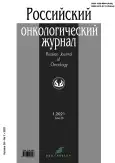Molecular biological characteristics of tumors and results of breast cancer treatment in males
- Authors: Zyuzyukina A.V.1, Slepov E.V.2, Vinnik Y.S.1, Zukov R.A.1,2
-
Affiliations:
- Krasnoyarsk State Medical University named after Professor V.F. Voyno-Yasenetsky
- Krasnoyarsk Regional Clinical Oncology Center named after A.I. Kryzhanovsky
- Issue: Vol 26, No 1 (2021)
- Pages: 5-12
- Section: Original Study Articles
- URL: https://journals.rcsi.science/1028-9984/article/view/56597
- DOI: https://doi.org/10.17816/1028-9984-2021-26-1-5-12
- ID: 56597
Cite item
Abstract
BACKGROUND: Male breast cancer is considered a rare condition – less than 1% of all breast cancer cases. 1607 cases of breast cancer were diagnosed by 2019 in Krasnoyarsk region and only 5 cases (0,31%) of the disease were in male patients.
AIM: This study aims to conduct a retrospective analysis of cases of breast cancer treatment in males in the Krasnoyarsk Territory for the period 1998–2019, as well as to assess overall and progression-free survival rates in this category of patients.
MATERIALS AND METHODS: A total of 28 males with diagnosed breast cancer received treatment at the Krasnoyarsk Regional Clinical Oncological Dispensary named after A.I. Kryzhanovsky in the period from 1998 to 2019.
RESULTS: Since 2013, an increase in breast cancer in males is noted in the Krasnoyarsk Territory. Average age of the patients at the time of diagnosis was 60.3±10.3 (range – 35 to 83 years). Allocating patients to the clinical stages: 8 patients (28.6%) were diagnosed with stage I of the tumor process, stage II was revealed in 12 (42.9%) patients, stage III was diagnosed in 7 (24.9%) patients and in 1 case (3.6%) cancer was found in situ. Metastatic lesions of the lymph nodes were revealed in 11 patients (39.3%): N1 – 9 patients (81.8%), N2 – 1 patient (9.1%), N3 – 1 patient (9.1%). Luminal A subtype was diagnosed in 3 patients (13.6%), luminal B (HER2-negative) – in 16 patients (72.8%), luminal B (HER2-positive) – in 2 patients (9.1%). 75% of patients received adjuvant therapy. As a result of the treatment, stabilization of the process was registered in 64.3% of cases. 4 patients (14.3%) suffered from recurrence of the disease; 2 patients (7.1%) were diagnosed with multiple primary cancer. For the entire observation period, fatal cases composed 4 (14.3%). Analysis of the overall survival rates for the male patients with breast cancer demonstrated a positive effect of endocrine therapy.
CONCLUSION: The results obtained indicate an increase in the incidence of breast cancer in men in the Krasnoyarsk Territory. Men have the tumor which is hormone-positive and administration of hormone therapy in the adjuvant mode increases overall survival rates.
Full Text
##article.viewOnOriginalSite##About the authors
Alena V. Zyuzyukina
Krasnoyarsk State Medical University named after Professor V.F. Voyno-Yasenetsky
Author for correspondence.
Email: alena-vz@mail.ru
ORCID iD: 0000-0002-6758-4800
SPIN-code: 6663-3600
Russian Federation, zd. 1, ul. Partizana Zheleznjaka, Krasnojarsk, Krasnojarskij kraj, 660022
Evgeniy V. Slepov
Krasnoyarsk Regional Clinical Oncology Center named after A.I. Kryzhanovsky
Email: slepov99@mail.ru
ORCID iD: 0000-0002-3787-3126
SPIN-code: 2097-0304
MD, Cand. Sci. (Biol.)
Russian Federation, KrasnoyarskYury S. Vinnik
Krasnoyarsk State Medical University named after Professor V.F. Voyno-Yasenetsky
Email: yuvinnik@yandex.ru
ORCID iD: 0000-0002-8995-2862
SPIN-code: 5070-8140
MD, Dr. Sci. (Med.), Professor
Russian Federation, zd. 1, ul. Partizana Zheleznjaka, Krasnojarsk, Krasnojarskij kraj, 660022Ruslan A. Zukov
Krasnoyarsk State Medical University named after Professor V.F. Voyno-Yasenetsky; Krasnoyarsk Regional Clinical Oncology Center named after A.I. Kryzhanovsky
Email: zukov.ra@krasgmu.ru
ORCID iD: 0000-0002-7210-3020
SPIN-code: 3632-8415
Russian Federation, zd. 1, ul. Partizana Zheleznjaka, Krasnojarsk, Krasnojarskij kraj, 660022; Krasnoyarsk
References
- Cardoso F, Kyriakides S, Ohno S, et al. Early breast cancer: ESMO Clinical Practice Guidelines for diagnosis, treatment and follow-up. Ann Oncol. 2019;30(10):1674. doi: 10.1093/annonc/mdz189
- Bray F, Ferlay J, Soerjomataram I, et al. Global cancer statistics 2018: GLOBOCAN estimates of incidence and mortality worldwide for 36 cancers in 185 countries. CA Cancer J Clin. 2018;68(6):394–424. doi: 10.3322/caac.21492
- Ruddy KJ, Winer EP. Male breast cancer: risk factors, biology, diagnosis, treatment, and survivorship. Ann Oncol. 2013;24(6):1434–1443. doi: 10.1093/annonc/mdt025
- Brinton LA, Carreon JD, Gierach GL, et al. Etiologic factors for male breast cancer in the U.S. Veterans Affairs medical care system database. Breast Cancer Res Treat. 2010;119(1):185–192. doi: 10.1007/s10549-009-0379-0
- Korde LA, Zujewski JA, Kamin L, et al. Multidisciplinary meeting on male breast cancer: summary and research recommendations. J Clin Oncol. 2010;28(12):2114–2122. doi: 10.1200/JCO.2009.25.5729
- Abrahams HJG, Knoop H, Schreurs M, et al. Moderators of the effect of psychosocial interventions on fatigue in women with breast cancer and men with prostate cancer: Individual patient data meta-analyses. Psychooncology. 2020;29(11):1772–1785. doi: 10.1002/pon.5522
- Keinan-Boker L, Levine H, Leiba A, et al. Adolescent obesity and adult male breast cancer in a cohort of 1,382,093 men. Int J Cancer. 2018;142(5):910–918. doi: 10.1002/ijc.31121
- Massarweh SA, Sledge GW, Miller DP, et al. Molecular Characterization and Mortality From Breast Cancer in Men. J Clin Oncol. 2018;36(14):1396–1404. doi: 10.1200/JCO.2017.76.8861
- Tynes T, Andersen A. Electromagnetic fields and male breast cancer. Lancet. 1990;336(8730):1596. doi: 10.1016/0140-6736(90)93387-5
- Rosenbaum PF, Vena JE, Zielezny MA, Michalek AM. Occupational exposures associated with male breast cancer. Am J Epidemiol. 1994;139(1):30–36. doi: 10.1093/oxfordjournals.aje.a116932
- Hoffman A, Ben Ishay O, Horesh N, et al. Breast Cancer in Men: A Single Center Experience Over a Period of 22 years. Isr Med Assoc J. 2020;22(3):160–163.
- Pan H, Zhang K, Wang M, et al. The effect of chemotherapy on survival in patients with nonmetastatic male breast cancer: A population-based observational study. Cancer. 2020;126 Suppl 16:3830–3836. doi: 10.1002/cncr.32829
- Cardoso F, Bartlett JMS, Slaets L, et al. Characterization of male breast cancer: results of the EORTC 10085/TBCRC/BIG/NABCG International Male Breast Cancer Program. Ann Oncol. 2018;29(2):405–417. doi: 10.1093/annonc/mdx651
- Cutuli B. Strategies in treating male breast cancer. Expert Opin Pharmacother. 2007;8(2):193–202. doi: 10.1517/14656566.8.2.193
Supplementary files











